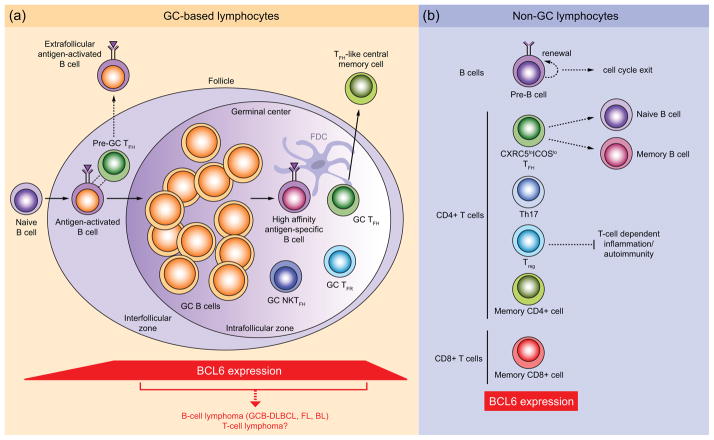Figure 1.
Lymphocyte subsets that require BCL6 for their development and effector functions. (a) GC-based lymphocyte subsets. Outside of the follicle, naïve B cells that become activated by antigen migrate to the interfollicular zone, where they up-regulate BCL6 and participate in interactions with pre-GC TFH cells, which also express BCL6. BCL6+ pre-GC TFH cells also promote the extrafollicular antibody response and production of short-lived plasma cells. Formation of the GC reaction requires further up-regulation of BCL6 expression in activated B-cells and involves the rapid clonal expansion and somatic hypermutation of GC B cells within the intrafollicular zone. Within the GC, high-affinity antigen-specific B-cells are provided help by BCL6+ GC TFH cells and NKTFH cells (and follicular dendritic cells (FDC) which do not express BCL6), of which GC TFH cells can go on to become BCL6+ TFH-like central memory T cells. The magnitude of the GC reaction appears to be regulated by BCL6+ GC TFR cells. High BCL6 expression in GC B-cells can lead to the development of GC-derived B-cell lymphomas, including GC B-cell (GCB)-type DLBCL, FL and Burkitt’s Lymphoma (BL). It is not yet known whether T-cell lymphomas can also arise from this compartment. (b) Lymphoid subsets that express BCL6 and reside outside of GCs include pre-B cells, CXCR5loICOSlo TFH cells, which provide help to naïve and memory B cells, Th17, Treg and memory CD4+ and CD8+ T-cells. BCL6 expression in CD4+ Treg cells helps to regulate T-cell-dependent inflammatory and autoimmune responses. Solid arrows indicate cell differentiation pathways; dotted lines indicate cell interactions and effector functions.

